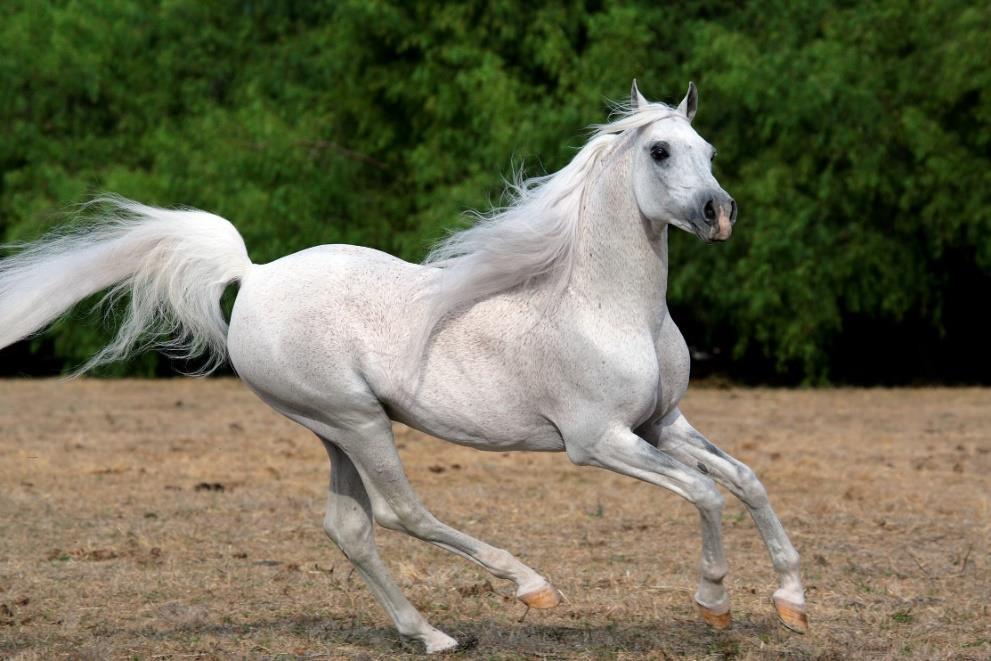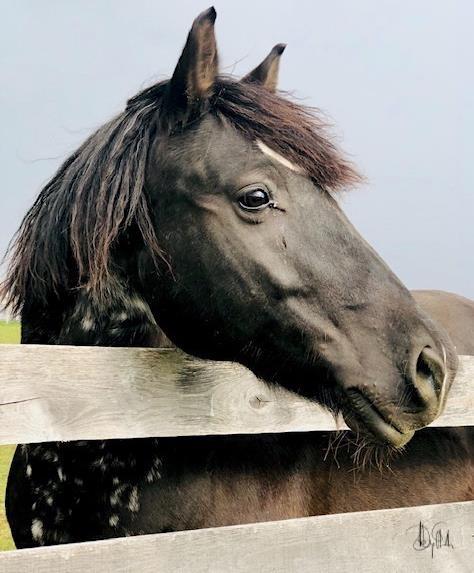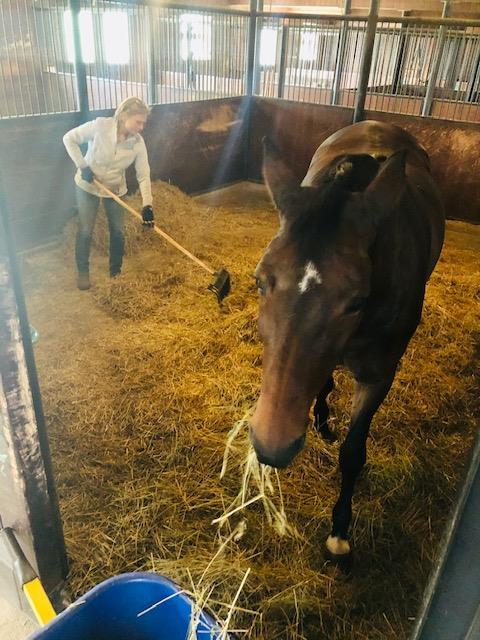
15 minute read
A Change In Perspective
Looking through the eyes of a horse
By: Esta G. Bernstein, U.S.A.
Advertisement

“There is nothing so good for the inside of a man as the outside of a horse. ~ John Lubbock”
No truer words were ever said. As we look deep into the behaviors and emotions of our equine companions, we discover a wealth of information about our own actions, reactions, and habits. As we go down this rabbit-hole, we discover how horses bring us to a level of awareness, including awareness of our life’s transitions. They can help us overcome the challenges that these transitions present. As we examine the energetic communication between our horses and ourselves, we see that they have always held the key for us to become comfortable with change.
CHANGE IS NOT THE END… IT IS ONLY THE BEGINNING
Horses and humans are creatures of habit. Both species are very comfortable with consistency, routine, and things that are familiar. Emotions and behaviors change in these species when their routines are disrupted. What emotional or behavior changes do horses go through when a herd member departs, or a new one arrives? When we are asking a horse to calm down, are we really speaking to ourselves? Are they our perfect mirrors when dealing with change? How do we step out of ego and realize that they are feeding us valuable information about ourselves?
Based on my experience, the answer is “yes,” horses can mirror our emotions to a “T.” Within these past thirty years of my rescuing and rehabilitating horses, I have seen an array of equine emotions and reactions on display, based on my own mood when I arrive at the barn, as well as observing their behavior when new or
familiar people come to volunteer at our rescue. If any of us are having an “off day,” we may be frazzled, upset, out of sorts, off our feed, and so on. Our emotions can run rampant when something in our life is in the middle of a shift. Many horses clearly do not like change, while some of them thrive on it. It is a very individual process for them, just as it is for us. Some of our horses are emotional rocks, waiting patiently for a cuddle when we feel more in balance. Some of them want nothing to do with us until we have recalibrated our attitude. What can we do to become more comfortable with change, especially if it is abrupt and sudden? How does our observation of horse behavior, as it relates to change, help us become more in control of our emotions and reactions?
When I am with a horse and connecting to it from its point of view (a place of authenticity and nonjudgment), it provides me with opportunities to
see where my beliefs, attitudes, emotions, and thoughts need adjustment. As divine mirrors horses gently, or maybe not so gently, nudge me into an emotional shift so I can bring myself up to their level of compassion and understanding. As I try to behave more horselike, I have found that changing my emotions, behavior, and mind set, will be as easy or as difficult as I choose to make it. When I step out of my ego, and flow with my heart’s intuition, change becomes much more comfortable. Intuition is the main survival skill that horses, and all other species have mastered. For us to become at ease with change, our left-brained human mind rationalization must shift to the back burner. Trusting my intuition is a lifelong practice that has become easier with time.
ACCEPTING CHANGE
From personal experience, I know that change is something that does not have to be feared. For example, when we are with a horse and we have a negative experience, such as being hurt unintentionally by it, because we are not being present and in the moment with our horse, we may become reluctant to be around that horse. It is natural that our survival mode kicks in and tells us we should proceed with caution, or not do that particular activity again because we may possibly risk injury. These can be very real scenarios, and what we once thought enjoyable and safe might no longer feel so.
Because horses (and some humans) equate change with something to be feared, in the most simplistic terms we can break down fear into three basic categories; 1) fear of becoming uncomfortable, 2) fear of injury, and 3) fear of death. However, it is our attachment to the material object (in the described scenario – our body) that causes pain and fear of change. While this pain is extremely real and necessary for our growth and expansion, it has a much greater purpose. This pain attachment allows us to be aware of our vibrational alignment, and how it can be adjusted so we can become a better version of ourselves. Being with horses teaches us to live in the moment. A horse’s natural default button is peace. They know all is well, and everything is in perfect divine timing. If we are able to move into that state of being, then we too will be comfortable with any change or challenge we are facing. This realization comes with the knowledge that the only thing we can truly change is how we feel.


NEW BEGINNINGS
One key piece of information I have learned from horses is that there cannot be change without some kind of death. The word death can be greatly misunderstood and feared as the word implies the end of something. It could be the end of a life, but it could also be the end of a belief, habit, or relationship. Being comfortable with an ending is essential to becoming comfortable with change. If we can transform our perspective, it can become a beautiful gift bringing us back to source; death can be viewed as a reset button. We are brought closer to alignment and that ending can be embraced and celebrated. Death can be seen as not an ending; it is just the beginning.
HORSES IN THE COSMIC PLAN
We are in the middle of an amazing global energetic shift. We are at a turning point where we have no choice but to accept change. What do horses have to do with this global change? My lifetime with horses tells me that the answer is “everything.” When we truly understand the depth of knowledge that lies within horses, the relationship between horse and human becomes a gift of clear communication, preparing us for the unexpected, seeing life through their eyes, while embracing how they can heal our deepest wounds. They bring us to our most vulnerable places so that these wounds are nurtured, and the emotions behind these wounds do not cut so deep. Having horses as our mirror for change is essential for our emotional and spiritual evolution.
Change exists so we do not become complacent. Change is the label for the universal process of our life force, which is constantly in motion and here to assist every living being with their spiritual evolution. Just like the caterpillar that becomes the butterfly, we would never be able to see things on a larger scale if we do not get off the ground. Change is the launching pad for new beginnings, opportunities, and adventures. It will bring you to where you need to be. If you are having trouble listening to your own advice, listen to the horse within. Nevertheless, when in doubt, or if you are having a challenging day, hug your horse. They are here to change with us. ~*~


Lynda Watson


SELF AWARENESS AND THE QUEST FOR SACRED SPACE
By: Dorothy Chiotti, Canada


“Because of how much time we spend thinking about something other than the moment we are in science suggests we are running on default programs about 95% of our waking life. … psychologists believe that the majority of default programs … are dis-empowering, self-sabotaging and limiting.” Bruce Lipton, The Biology of Belief
When was the last time you aspired to achieve a big dream only to lose faith and abandon it for reasons you don’t understand?
Sadly, even our most noble intentions can be undermined by a lack of self-awareness. From that place of unknowing that influences all areas of our lives, including any desire we may have for creating sacred space, self-sabotage is born. There are reasons we act the way we do and believe what we believe, and often they have nothing to do with us at all. Until we step into self-awareness and begin to release the burden of old, toxic beliefs the desire for authentic sacred space, or any other worthy dream, remains elusive.
EMOTIONAL BAGGAGE
All of us carry some form of emotional baggage. To understand what we’re dragging around it’s helpful to observe the environment, people and activities we attract. For we draw to us who and what we are and deflect who we are not. As energetic mirrors, horses can attune us to this understanding and the underlying emotions. They sense when we’re inauthentic and resist a connection with us until we’re connected to ourselves.
And that’s the challenge.
As children we behave like energy sponges and, unable to set appropriate boundaries, become an unwitting dumping ground for the dysfunction, despair and disappointment of those who influence us. The emerging field of epigenetic science also suggests we carry the energetic imprint of unresolved ancestral trauma/drama, including the emotional residue of every battle our ancestors fought; every hardship endured; every triumph celebrated, and on. It also suggests we wear the toxic traditions and prejudices that informed their


experiences like a truth crippling straitjacket. How does this present? We defend the old family ways even when they don’t feel right, often to appease our elders and at the expense of our own integrity.
Add to this our own stuff accumulated day-today, while negotiating the world based on toxic subconscious programming, and it’s little wonder life can feel overwhelming. The clash of disruptive energies amplifies a disconnect. In our vain attempts to feel accepted and loved by family, friends and co-workers, we become exhausted appealing to their debilitating nothing-is-ever-enough dramas. Consequently, nothing is ever enough for us and we get sucked into the proverbial bottomless pit of need.
POWER TO CHANGE
When we have the courage to shine a light into the dark crevices of our subconscious and poke around at the old survival mechanisms, we give ourselves the power to change our behaviour. Self-awareness is the only way to start healing and integrating a more dynamic way of life. The will to thrive must be stronger than our survival programming if we wish to manifest our purest intentions. In an effort to maintain the status quo the embattled ego will find excuses to hang on to old survival patterns. Our responsibility is to nurture it to thrive.
There are three key areas in which we need to raise our self-awareness:
1. Personal ~ the internal realm … What subconscious dramas/traumas linger that inflict themselves on our outer world?
2. Intimate ~ the immediate space between us and others … How do these dramas/traumas manifest during personal interactions? What gets triggered? (Indignation/injustice; defensiveness/fear of rejection; etc.)
Who pulls the trigger?
3. Environmental ~ the outer world … What personal drama/trauma is projected into, and reflected back to us, in our surroundings?
Self-awareness ensures integrity behind the intention of creating authentic sacred space. Still, there are some threats to ponder:
1. Fear ~ Creating sacred space requires a shift from the lower vibration of fear to the higher vibration of faith. We do this by boldly exploring the dark void where
our personal monsters lurk; making peace with them and then letting them go.
2. Lack of intention/commitment ~ If the intention is to generate sacred space, we must be prepared to release everything that doesn’t support our desire to be authentic and thrive.
3. Lack of self-awareness ~ Only by identifying the root of our dis-ease can it be plucked out. Acknowledging anger, frustration, grief, sadness and depression as by-products of deeply held pain needing an exit strategy is key. i.e., What past/ancestral stories still influence how we treat ourselves, others and the environment? Awareness of the stories and buried emotions that shape us creates room for the healing process to unfold.
4. Doubt/weakness ~ It takes courage, strength and a sense of humour to get real with ourselves. Appropriate support as well as the desire to be you are important to having true oversight of the healing journey.
WAKE-UP!
How does the journey begin? A family death, job loss, or serious personal illness, etc. often provide the impetus. I was 32 when the death of my maternal grandmother gave me a cosmic wake-up call. Within eight months I quit my public relations gig and followed a life-long dream of working with horses via an intense 18month equestrian coaching internship. Without realizing it my healing journey had begun.
MUCKING METAPHOR
An appropriate metaphor that surfaced during the internship was that of mucking a horse’s stall. This seemingly unappealing, mundane task became a meditation enabling me to engage in the sacred process of clearing and revitalizing space in a holistic way. A soiled stall cleared one pitchfork load at a time creates a healthy living space for the horse. Similarly, the healing journey is a continuous mindful gathering and disposing of the old to make room for the new.
To cite a personal example, as a child I adopted the practice of invisibility to avoid negative attention. If no one could see me no one could hurt me. As I grew to adulthood, this well practiced, fear-based survival mechanism interfered with my ability to thrive. Years of personal work, including cognitive therapy and equine experiential learning have helped me to look at this piece of emotional baggage and engage in the ongoing methodical process of unpacking it.


SIX STEPS
The mucking metaphor highlights six steps to establishing authentic sacred space. With each dig of the proverbial pitchfork, we give ourselves the opportunity for:
1. Recognition ~ Identifying a toxic emotion enables us to begin to recognize it for what it is ~ the unhealthy residue of a past trauma or drama that needs to be processed and purged.
2. Separation ~ Having recognized the toxic emotion we can separate it from our “dis“comfort zone and mindfully examine what’s behind it. 3. Examination/Process ~ Asking key questions is crucial. i.e. Does a toxic relationship need to be ended? Is forgiveness involved? Does a bad habit/negative life pattern need to be changed? Does an ancestral trauma need to be released? It’s worth noting that the source of our dis-ease can be deeper and heavier than we imagine, requiring appropriate qualified help to process.
4. Disposal ~ Once the root of our dis-ease is identified, examined and processed we need to dispose of it. This isn’t a onetime thing. Much like the daily mucking of a stall, we must be attentive to clearing and releasing mindfully, and regularly, the back-up of negative emotions, before they get triggered. The more practiced we become at selfawareness, the easier the process and the more authentic our sacred space.
5. Composting ~ Properly disposed of organic waste breaks down to become the very ingredients needed to fertilize new growth. This is true of our emotional waste. The old stories and feelings we process, release and compost become the fertile bed of wisdom that supports the ongoing journey.
6. Replenishing ~ Filling the void with fresh perspective is vital. Reading good books, meditating, embracing new, openhearted friends, listening to inspiring talks or music, etc. helps, along with our growing trove of wisdom, to establish the nurturing foundation for our sacred space.
As an experiential exercise, a horse nearby can provide immediate feedback. For instance, one day my own horse Sophi, was in her stall with me as I mucked it. At one point she began digging at a pile of reusable straw I’d cleared into a corner. It was an uncharacteristic practice, so I felt into it for a moment. When I realized she was showing me how my busy thoughts were looking for problems where none existed, she stopped digging and turned to acknowledge me. Her feedback gave me immediate permission to let go of the mill of thoughts running through my head, and I relaxed.
Horses can teach us to be present and more fully engaged with life in many profound ways. With the mucking metaphor we’re offered another experiential way to identify, meditate upon, and purge the default programming that perpetuates our self-sabotaging ways. Once we’ve made a commitment to release toxic behavioural patterns and nurture our authenticity, the sacred space of our dreams has room to create itself. ~*~










